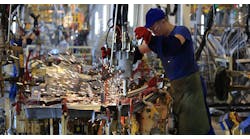Taiichi Ohno, father of the Toyota Production System, was once quoted as saying that in manufacturing improvement:
“All we are doing is looking at the timeline, from the moment the customer gives us an order to the point when we collect the cash. And we are reducing that time by removing the non-value- added wastes.”
Ohno was, in fact, stating that the basis of the Toyota Production System was how efficiently a company conducts order fulfillment, which, of course, is based on operations. And lean activity was the approach Toyota used to remove that “non-value-added waste.”
I have found that all too often, a company will view a lean mindset as pertaining to its own operations. However, Ohno wasn’t speaking just about order fulfillment within the walls of Toyota factories. Rather, he was referring to order fulfillment across Toyota’s entire supply chain, including the delivery time between suppliers and customers. Too many OEMs today don’t understand this. They also don’t understand that the unspoken truth behind the power of the Toyota Production System is that it focuses on reducing order fulfillment time through a product’s critical-path; i.e., its “true” lead time.
Order fulfillment effectiveness is the result of operational agility throughout an entire supply chain. In this, waste can take many shapes, but for our purposes we’ll focus on pre-built inventory. Suppliers have the option of basing their support of customer demand to ship—at least partially—out of pre-built inventory. Similarly, OEMs have the option of hitting their customer-fill-rate goals by supporting market demand through shipping from pre-built finished product.
Pre-built WIP and finished goods inventory is on the critical path and consequently contributes—more than you’d think—to overall “true” lead times, both at suppliers and at their OEM customers. Both WIP and pre-built finished goods are waste. Consequently, the less a supplier or OEM relies on waste in their order-fulfillment planning, the lean-ner they are. Another way of saying this is that as a manufacturer works to become less and less reliant on pre-built inventory, they are increasing their build-to-demand capability.
Order Fulfillment Risks:
There are business cases where long, complex supply chains are justified, and there are others where they are not. Each sourcing decision should include assessing the demand characteristics of the market in which the purchased parts are used and a potential supplier’s ability to support them.
For instance, there is reduced risk in long, complex supply chains when demand is steady and demand forecasts are historically accurate. On the other hand, there is significant risk when suppliers need to support markets where demand is seasonal, variable and/or forecasts historically contain excessive error. Consequently, in the first instance, build-to-demand capability is of less import, while in the second, it is of ultimate importance, at least regarding customer fill rates.
Overseas suppliers typically require long and complex supply chains in supporting U.S.-based OEMs while domestic suppliers do not. A comparison between the above two order fulfillment strategies follows.
Overseas Sourcing vs. Domestic Sourcing
Market Demand: Steady throughout the year vs. seasonal
Why: With consistent yearlong and year-to-year demand, there is usually little need to adjust schedules. On the other hand, with variable seasonal demand, production must be agile, or sales will be lost.
Customer fill rate is a big deal to manufacturers, since it defines the percentage of time where product is unavailable to customers when they want to buy it. As Ohno says, the ultimate goal of manufacturing should focus on the “the point when we collect the cash.” If you don’t have product available to sell to customers, that is bad in both the short- and long-term. In the short time it affects current year financials. Over the longer term, low customer fill rates give a manufacturer a reputation as a non-reliable source, similar to suppliers that have a history of low “on-time” delivery performance. In both cases, business is usually lost.
Forecasting: History of Significant Error vs. High Accuracy
Why: As cited above, longer “true” lead-times don’t allow for flexible response to demand. This implies that overseas sources can’t directly support variations in market demand. Along these lines I recently read an article where the manager of a domestic manufacturer said:
“It takes three to six weeks for foreign sources to manufacture product.”
This Ohio-based manufacturer had been able to marshal the needed supply chain to support production of plastic face shields --- a new product to them --- within three weeks! This meant his company was agile enough to support increased upside market demand.
But the statement above is not completely accurate. Many overseas suppliers have, over time, become just a lean as their U.S.-based counterparts, meaning that their internal factory order fulfillment doesn’t take any longer than that of U.S. based manufacturers. What I think the quoted individual meant is that it takes from 3 to 6 weeks for overseas suppliers to satisfy order fulfillment, most of that time being in logistics. Think about this. If flexible market response is important to an OEM, then the much shorter “true” lead-times of domestic suppliers represents a tremendous competitive advantage to U.S. manufacturers, at least when selling to U.S.-sited customers.
For that to matter, however, OEMs both must be able to understand and quantify both how supplier agility affects their customer fill rates and how it relates to their own internal overhead costs that are not typically attributed to the purchasing function. Unfortunately, in my experience, it is a rare OEM that can accurately do this.
Production Commitment: Longer vs. Shorter
Why: Back in the day when I signed contracts with overseas suppliers, most required a three-month firm commitment on schedule. What this meant was that my company was beholden to them for the amount of product in our three-month rolling schedule and wouldn’t expect suppliers to change SKU mix or amount within that three-month period. Again, back in the day—through supplier development assistance—I worked with suppliers so that they only required a two week commitment, after which they could increase the quantity of product manufactured and delivered to us by up to 20%. This type of flexibility was needed to support the demand characteristics of our market.
And, I might add, almost all of those were domestic sources because they were—for the most part—the only suppliers that had this level of build-to-demand capability.
In the end, this sourcing strategy had a much higher positive impact on our financials than if it had been primarily based on lowest quoted piece-price.
Now I’ll cite another example of how long, complex logistics can significantly increase operational risk.
A highly visible manufacturer—who I’ll not name but whose yellow off-road products you’d you’ve undoubtedly seen before—awarded business primarily based on lowest quoted piece-price. This meant that a great percentage of their suppliers ended up being overseas. Because of the class of product, the purchased parts that were used on many were both bulky and heavy, such as castings and weldments.
One year, there was unanticipated surge in demand for that company’s products. Since their lowest piece-price sourcing strategy had resulted in long supplier “true” lead-times, the OEM wouldn’t be able to quickly ramp up production and as a result faced losing sales to competitors.
Their solution? To be able to support market demand, the company air-freighted parts from China to their domestic manufacturing/assembly facilities. And because the parts were bulky and heavy, it cost $200 million dollars in logistics above-and-beyond what had been budgeted.
I’m not revealing confidential information, above as this financial impact was significant enough that was called out in that company’s annual report, and attributed to purchasing. Ouch! That would have been a chair I wouldn’t want to have been sitting in.
The bulk of an OEM’s “true” order fulfillment lead-time is in their supply chain. Because of this, sourcing decisions that don’t include evaluation of whether potential suppliers can support the market demand of the OEMs expose the manufacturer to operational risk. In general, demand in markets worldwide is becoming more and more variable—and customers expect short-fused demand to be satisfied quickly, much more so than they did in the past.




